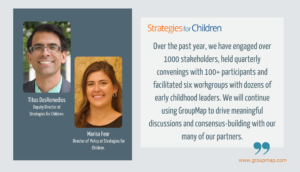
Still thinking about reasons why your team should start virtual brainstorming?
We have access to an incredible array of technological developments that can change the way we work; from online collaborative tools and virtual workspaces, through to web-based mechanisms for team decision making.
With so many tools at our fingertips, it’s becoming easier to embrace an online workflow that fosters collaboration and enhances productivity.
Group brainstorming is no exception. In fact, in this Harvard Business Review article and meta-analysis, creative performance of virtual versus in person brainstorming sessions showed a different of almost 50% of a standard deviation and that “70% of participants can be expected to perform worse in traditional than virtual brainstorming sessions.”
Leading companies, agile teams, and workshop facilitators often use group brainstorming to create –
- Solutions to challenges,
- Answers for questions, and
- An inspiration that sparks new products and ventures.
While group brainstorming can be an incredibly valuable mechanism, traditional brainstorming isn’t always effective. Indeed, traditional (face to face) brainstorming comes with inherent challenges such as –
- A clash of egos
- Groupthink and production blocking
- Not all voices heard
All of which may negatively impact the quality of the decision the brainstorm was to inform. The great news is, there are effective online brainstorming tools that can help overcome these challenges. So if you’re wondering if your team should start virtual brainstorming, the answer is a very loud yes!
Here are five reasons why!
Why Should My Team Start Virtual Brainstorming?
Reason 1 – It creates a level playing field
Production blocking describes a context that happens when not all participants have the opportunity to speak up or contribute during traditional brainstorming.
There can be many reasons for this. There may be someone with a particularly dominant personality in the group who enjoys the spotlight. Several people may try to speak at once. An idea may be challenged before it is recorded. The group may become involved in a conversation and the idea forgotten before it is recorded.
Additionally, the ideas themselves may influence the information that is shared. Participants may anchor onto the first few ideas and start to converge onto a few thoughts rather than being able to share different perspectives.
Instances such as these limit idea generation.
With virtual brainstorming, each person in the group can share their ideas in real time, free from distraction and bias.
GroupMap, for example, allows people to brainstorm in real time individually, with ideas then being combined on the same brainstorming template. Similar ideas can be seen and grouped.
The chance to brainstorm individually has allowed everyone to put their ideas forward and share those ideas then quickly inspire new ones.
Reason 2 – It supports a psychologically safe space
When people are apprehensive about a task, they are less likely to contribute effectively to that task.
In the case of traditional brainstorming, people may feel apprehensive because –
- They may be uncomfortable speaking up in a group.
- They may be unsure of the subject or lack confidence in the validity of ideas.
To put it simply – they don’t feel safe.
With such apprehension present, the effectiveness of the brainstorming session could be impacted –
- Participants may limit their contributions to the brainstorming.
- Participants may self-edit ideas.
These behaviors aren’t deliberate, they are defense mechanisms people unconsciously activate when they encounter a situation in which they feel uncomfortable. They may limit or edit their ideas to lessen the likelihood of being called upon to explain what they meant or reduce the chance of their idea being challenged.
Virtual brainstorming tools often include simple features to hinder the activation of that personal defense mechanism.
Online brainstorming tools allow participants to contribute with full or partial anonymity. In doing so they are more likely to feel more confident about sharing their thoughts and suggestions with the group without feeling judged.
Allowing participants to contribute anonymously often increases –
- Participation and engagement rates.
- The number of ideas generated.
That’s right when brainstorming anonymously, people feel safer, and therefore contribute more!
Reason 3 – Encourages a greater range of ideas
When you’re amongst a group of friends do you ever find yourself agreeing to something that you don’t really want to do? Perhaps heading to a restaurant you don’t particularly like or sitting through a movie you never wanted to see?
Why?
It’s most likely you find yourself in those situations because you want to keep the peace; those decisions aren’t a big deal so you just go with the flow and agree with the group.
You’ve just experienced groupthink – a phenomenon that sees a desire for harmony within a group of people strongly influencing the decisions of that group.
The same thing can happen when brainstorming with a group of people. Once one person sees an idea, they are less likely to share an opposing view. In fact, that idea may influence them to the extent that they suggest similar ideas.
Virtual brainstorming makes counteracting groupthink incredibly easy. It’s possible to manage the process of the brainstorm so that participants brainstorm separately before all ideas are shared (at the same time).
In addition to managing the process, virtual brainstorming tools offer a large variety of creative templates to spark thoughts, so participants aren’t just staring at a blank page. Changing up the templates is a great way to prompt participants and help them to consider different contexts. It’s also possible to adapt those templates (even mid-brainstorm!)
By compensating for groupthink and building a context to spark creativity, virtual brainstorming tends to encourage a far broader range of ideas than a traditional approach.
Reason 4 – Transparent decision making
When it comes to decision-making, transparency ensures those decisions are informed and equitable.
Transparency reduces opportunities for undue influence and bias; so decisions made via a transparent process are less likely to be challenged, and more likely to be accepted and trusted.
Unlike those reached via general discussion, decisions made using an appropriate virtual tool are more likely to be transparent simply because every step of the decision-making process can be captured, reviewed, and quantified.
An online brainstorming tool could allow all participants to prioritize ideas (color coding, positioning on a radar, ratings, rankings, etc) in order to surface those they perceive to be most important. Facilitators can then easily see if participants’ thoughts are aligned, or if different perspectives require exploration.
Features such as anonymous voting allow all participants the opportunity to opt for the ideas they wish, without others knowing how they voted. Again removing the likelihood of influence.
With all data captured, the passage of time (with our propensity for forgetfulness) doesn’t erode the legitimacy of the decision.
Reason 5 – Faster, unbiased reporting
Virtual brainstorming side-steps the need to double handle information.
Unlike traditional brainstorming, there’s no need to copy ideas from sticky notes, flip charts, and whiteboards. WIth participants directly entering their ideas into the tool, there’s simply no need to retype them.
Because it’s digital, ideas don’t have to be limited to the few words that can be recorded on a post-it. Participants can comment on each other’s ideas, they can even add emojis and GIFs! Any grouping or voting on ideas is also instantly recorded, and there’s no risk of a miscount!
That direct entry of ideas also ensures that the participant’s idea or comment is represented as they intended, and not misrecorded or interpreted by someone jotting down the idea on their behalf.
Not only can inputs from a virtual brainstorming session be captured quickly and accurately, but the reports can also be used to assess the elements of the brainstorm.
GroupMap supports reports that can be generated based on a myriad of criteria (the process, the participants, the ideas, comments, and more).
Virtual brainstorming means there’s no need for a ‘scribe’ to capture ideas generated by the brainstorming process. It also means that the facilitator doesn’t need to spend hours compiling information post brainstorm.
The Bottom Line: Take Your Brainstorming Sessions to Another Level with Virtual Brainstorming
Shifting from traditional brainstorming to a virtual space allows team members to feel comfortable in creating more, broad-ranging ideas, that are quickly and objectively captured.
If you haven’t guessed it already and you’re keen to use effective brainstorming tools and techniques to take your team’s brainstorming sessions to another level, you’ve come to the right place.
GroupMap is an online brainstorming and group decision-making tool that helps improve the output and productivity of teams during brainstorming activities.



